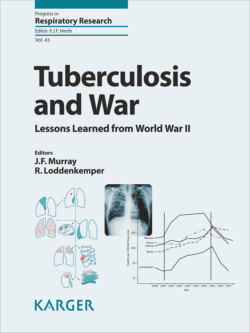Читать книгу Tuberculosis and War - Группа авторов - Страница 52
На сайте Литреса книга снята с продажи.
Age and Sex
ОглавлениеIt is well-known that TB frequency may differ substantially by age and sex. During wartime, the epidemiology in this respect may change considerably, as illustrated in Figure 6 in Bavaria.
Fig. 6. Mortality rates for all forms of tuberculosis by sex and age for Bavaria (1938 and 1946) and United States of America (1939–1941). a Males, b females. Fig. 2 from [9].
Age-specific rates for each sex for the years 1938–1946 were compared with the corresponding rates for the white population of the United States averaged for 1939–1941 [9]. “In 1938, Bavaria’s age distribution of mortality in both sexes was roughly parallel to, although somewhat higher than that in the United States. In 1946 the TB mortality for males in Bavaria was greatly increased in infancy and in all adult age groups (Fig. 6a). The most marked excess was in the 20–34 year age span and it was assumed that the excessive mortality among repatriated prisoners has contributed to this high rate. Roentgen surveys of such groups have revealed a high prevalence of significant TB. Among females, on the contrary, the only population groups showing an increase in 1946 as compared with 1938 were infants and young children, among whom a rise similar to the male rise was recorded (Fig. 6b). There was practically no difference between prewar and postwar mortality in adult females. Presumably had there been no war, the 1946 rates would have shown a decrease, but at least there was no rise. The increase in infant mortality from TB in both sexes suggests that, at least in this age group, the frequency of infection was greater in 1946 than before the war.” One reason may have been the imperfect or absent pasteurization of the milk [32].
As an additional explanation, it was assumed that there was a sex selection process during the war among the civilian population. Healthy males were drafted to the army, were killed or returned sick – in particular, after war captivity – whereas the non-drafted males had prevalent TB [14].
